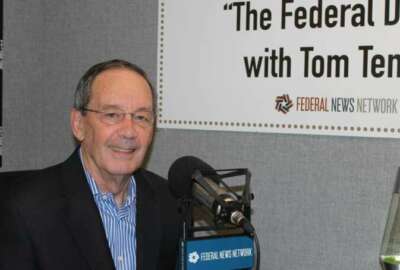
Free training available to become coronavirus contact tracer
State and local health agencies are offering free training for anyone who wants to become what's known as a COVID-19 contact tracer.
Best listening experience is on Chrome, Firefox or Safari. Subscribe to Federal Drive’s daily audio interviews on Apple Podcasts or PodcastOne.
State and local health agencies are offering free training for anyone who wants to become what’s known as a COVID-19 contact tracer. The training program is organized through two organizations — the National Coalition of STD Directors and the Association of State and Territorial Health Officials. The association’s chief population health and innovation officer, J.T. Lane, joined Federal Drive with Tom Temin.
Interview transcript:
Tom Temin: Mr. Lane, good to have you on.
J.T. Lane: I am glad to be here.
Tom Temin: First of all, what is a contact tracer? What do these people do and who do they work for in general?
J.T. Lane: Great question. Contact tracers are a key component of our COVID-19 response nationally. These are usually individuals that work in state or local health departments and other entities that work to identify cases in a deaf high context of COVID-19 cases. And ensure, they interview individuals that are contacts and they sort of ensure that their access to any testing or resources they may need to get more education about potential exposure, what they need to do, a conversation they have with their provider etc. And contact tracers and case investigators who also do additional follow up with individuals usually work within the 59 state and territorial health departments and nearly 3000 local health department’s nationwide. They’re a key component of the COVID-19 workforce.
Tom Temin: And so you are offering training then for people that may be just private citizens that want to get into this type of work.
J.T. Lane: So the training will largely be administered through the state and local health departments. So as we look to reopen in various phases as various governors, local officials and federal officials are planning a key activity to helping contain the spread of COVID-19, it’s through the work of contact tracers. And so local health departments and state health departments are leading the effort to recruit, train and deploy teams of contact treasures within their jurisdiction. So that is the criticality and the need of the training. So they’re going to start with our training that is there to provide the fundamentals of the activities of contact tracing everything they need to know about COVID-19 fundamentals of effective communication and interviews, and the fundamentals of case monitoring and how they sort of refer people to the resources they need as well.
Tom Temin: Because it sounds like potentially sensitive work, and they might have access to some private information that as a government official or designee, they would really have to be careful with.
J.T. Lane: That’s correct. They’re gonna be dealing with potentially personal health information of those cases and their contacts. So it is a very sensitive work, very important work, which is why training is so important and part of the training that we are offering includes privacy, HIPAA content and confidentiality, and security as well.
Tom Temin: Now some countries have turned to cell phone data and location data for people tracking, if you will. Is this part of the training or part of the contact counting effort in the United States yet?
J.T. Lane: There are several jurisdictions that are piloting different approaches. Some are trying to find ways to leverage apps or digital solutions to act as a sort of a workforce multiplier for the contact tracing workforce. And so there’s activities and approaches they’re piloting that can help support the work of the workforce, such as documenting cases or contacts of cases, within an app, for instance, that then a contact tracer would use to further follow questions of the case and contacts for etc. In summary trying to find ways to effectively use apps to do exposure notification or just general health education that, you know, if you feel like you’ve been in contact with someone with COVID, then you can sort of get access to the nearest testing site, for example. So there’s a wide variety of applications out there for different uses. And don’t think that there’s a standard approach or standard offering. There’s certainly a lot of piloting going on because frankly we have not deployed our technological capabilities in this way. So there’s a lot of learning going on.
Tom Temin: And what is the federal role on this? It sounds like this is the kind of data that can be rolled up to some of the federal health agencies as they try to deal with this on a national level.
J.T. Lane: Well, sure, and certainly, we’re working with Congress and agencies on a solution to fund a national workforce. So we’re working with various leaders to educate them on the needs of state and territorial health departments. There’s, as you might imagine, there’s been a contraction of the public health workforce over the past couple of decades. And so we you know, estimate that we’ll need at least 100,000 contact tracers nationwide, if not more. Obviously, that will depend upon how well we’re able to contain the spread of the disease here in the United States. We are working to secure federal funding for the state so they can expand their contact tracing workforce and capabilities as soon as possible.
Tom Temin: I wonder if you could convert some of the census enumerators when their work is done. They’re already out on the streets and kind of know this kind of thing.
J.T. Lane: So there’s been some innovative approaches in several jurisdictions as they’ve been trying to ramp up pretty quickly. There’s been cases like in San Francisco where initially, they repurpose librarians with sort of a technical background that could be trained that were sort of led by a nurse or a clinical SME, that could train that group of librarians because their public library systems closed. They could be deployed as initial contact tracers to make that first contact with those contacts of cases. Census, you mentioning the census employees. Absolutely. That’s one other source of workforce. Some states are also in in local health departments as well are repurchasing employees that are doing non essential or non critical functions to the functional contact rates. And so, as we sort of await maybe a national solution funding for this, there’s a variety of ways that states are trying to get this teams ramped up pretty quickly.
Tom Temin: And does your organization ASTHO, do you have any federal grant money? Or is there some federal help for this efforts? It’s diffused throughout the nation.
J.T. Lane: So that’s what we’re working with in Congress side. The current ask for with congressional leaders and agency are in working in collaboration with federal partners and members of Congress and congressional staff. We put the price tag currently at 7.6 billion to be included in the next emergency supplemental bill to expand the scale of a disease investigation case and contact tracing workforce in the state territorial and local, tribal, and federal public health agencies. So it’s definitely something we’re tracking closely and working with all the right partners to educate them and make sure they understand the the critical need of this to reopen the United States.
Tom Temin: And what has the take up been for the training opportunities so far?
J.T. Lane: It’s been pretty good than the last five days. We’ve had more than 5000 registrants for the course. And nearly 2000, completions meaning they got their certificate of completion at the end and we anticipate that will grow. We’ve had individuals from all 50 states and all of our territories as well take the training as well. So we’re getting a good coast to coast and Atlantic to Pacific reach with the training and anybody who wants to take it, it’s free and they can access that learn.astho.org.
Tom Temin: J.T. Lane is the chief population health and Innovation Officer at the Association of State and Territorial Health Officials. ASTHO, thanks so much for joining me.
J.T. Lane: Thank you Tom. It was my pleasure.
Copyright © 2025 Federal News Network. All rights reserved. This website is not intended for users located within the European Economic Area.
Tom Temin is host of the Federal Drive and has been providing insight on federal technology and management issues for more than 30 years.
Follow @tteminWFED
Related Stories





